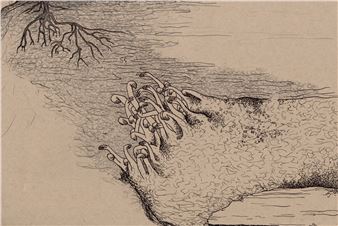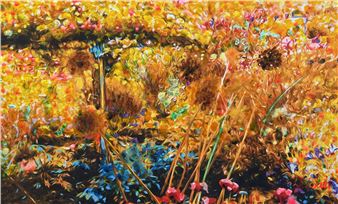Fernando Palma Rodr铆guez: Tlazohuelmanaz (offering of love)
Tlazohuelmanaz (offering of love) is a solo exhibition by artist Fernando Palma Rodr铆guez that features a series of newly commissioned robotic sculptures that interweave art, nature, and technology. The first solo museum exhibition of Rodr铆guez鈥檚 work to be presented in the context of the United States-Mexico Borderlands, Tlazohuelmanaz explores shared issues like climate, water, and the care for Indigenous knowledge, which impact both the artist鈥檚 home and community in Milpa Alta, Mexico as well as communities in the Sonoran Desert.
Rodriguez鈥檚 sculptural environments transform everyday materials like aluminum cans, cardboard, comales (cooking pans), masa, salt, and laundry, to create figurative sculptures like coyotes, rattlesnakes, rivers, and rain. These sculptures are animated with idiosyncratic movements generated by custom-built hardware that combines mechanical, electronic, and computer engineering systems, and reflects an approach to technology that decentralizes human agency and underscores interdependent relationships with nature. Combining ancient and contemporary technologies with organic material and robotic parts, Rodriguez generates new, hybridized sculptures and narratives that are in conversation with the complexity of life in the borderlands.

Tlazohuelmanaz (offering of love) is a solo exhibition by artist Fernando Palma Rodr铆guez that features a series of newly commissioned robotic sculptures that interweave art, nature, and technology. The first solo museum exhibition of Rodr铆guez鈥檚 work to be presented in the context of the United States-Mexico Borderlands, Tlazohuelmanaz explores shared issues like climate, water, and the care for Indigenous knowledge, which impact both the artist鈥檚 home and community in Milpa Alta, Mexico as well as communities in the Sonoran Desert.
Rodriguez鈥檚 sculptural environments transform everyday materials like aluminum cans, cardboard, comales (cooking pans), masa, salt, and laundry, to create figurative sculptures like coyotes, rattlesnakes, rivers, and rain. These sculptures are animated with idiosyncratic movements generated by custom-built hardware that combines mechanical, electronic, and computer engineering systems, and reflects an approach to technology that decentralizes human agency and underscores interdependent relationships with nature. Combining ancient and contemporary technologies with organic material and robotic parts, Rodriguez generates new, hybridized sculptures and narratives that are in conversation with the complexity of life in the borderlands.

 ARTISTS
ARTISTS











